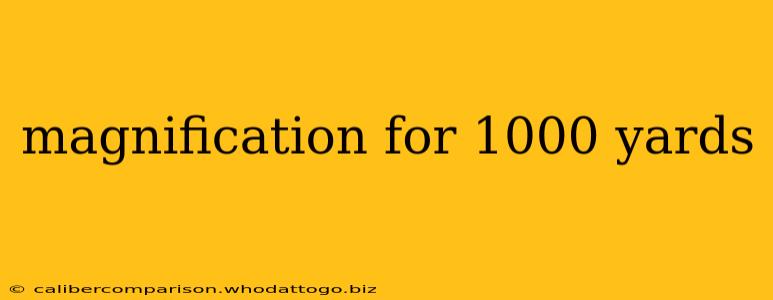Long-range shooting presents unique challenges, and selecting the right magnification is crucial for accurate target acquisition and shot placement at distances of 1000 yards and beyond. This isn't simply about choosing the highest magnification available; it's about understanding the interplay between magnification, target size, environmental conditions, and your personal shooting style. This guide delves into the factors you need to consider when determining the optimal magnification for your 1000-yard shooting needs.
Understanding the Role of Magnification at 1000 Yards
At 1000 yards, even seemingly large targets can appear incredibly small. Magnification significantly impacts your ability to:
- Identify the Target: Clearly distinguish your target from surrounding elements.
- Assess Windage and Elevation: Accurately judge wind drift and bullet drop.
- Make Precise Adjustments: Fine-tune your scope's adjustments for optimal accuracy.
Factors Influencing Magnification Selection
Several factors interplay to determine the ideal magnification level for your 1000-yard shooting setup:
1. Target Size
The size of your target is paramount. A larger target will require less magnification than a smaller one. Consider the specific target you'll be engaging and its apparent size at 1000 yards.
2. Scope Quality and Clarity
High-quality optics are essential for long-range shooting. A superior scope with excellent glass and lens coatings will provide a clearer, sharper image at higher magnification levels than a lower-quality scope.
3. Environmental Conditions
Weather conditions significantly impact visibility. Fog, haze, rain, or even extreme heat can reduce clarity, making higher magnification less effective. Lower magnification might be preferable in less-than-ideal conditions to maintain a bright, clear image.
4. Rifle Stability and Recoil
Higher magnification can amplify the effects of recoil and rifle movement. A stable shooting platform and a rifle that manages recoil effectively are essential when using higher magnification levels.
5. Personal Preference and Shooting Style
Ultimately, the "best" magnification is subjective and depends on your shooting style and comfort level. Some shooters prefer a higher magnification for precise adjustments, while others prioritize a wider field of view at lower magnification for quicker target acquisition.
Recommended Magnification Ranges
While there's no single "perfect" magnification for 1000 yards, the following ranges provide a helpful guideline:
-
Lower Magnification (6-12x): Suitable for quicker target acquisition, wider field of view, and shooting in challenging conditions. Ideal for situations requiring rapid target identification and engagement.
-
Mid-Range Magnification (15-25x): Offers a balance between field of view and magnification. A good option for many long-range shooters, providing sufficient magnification for precise shot placement while maintaining a reasonable field of view.
-
High Magnification (25x and above): Provides exceptional detail, crucial for extremely small targets or for precision adjustments at extreme ranges. Requires a very stable shooting platform and excellent optics.
Choosing the Right Scope
When selecting a scope for 1000-yard shooting, consider these additional factors:
- Focal Plane: First or second focal plane, depending on your preference.
- Reticle: Choose a reticle that suits your shooting style and provides necessary aiming points.
- Turret Adjustments: Ensure your scope offers precise and repeatable adjustments for windage and elevation.
Conclusion
Selecting the appropriate magnification for 1000-yard shooting requires a thoughtful consideration of various factors. The ideal magnification is not a fixed number but rather a choice informed by your target, conditions, equipment, and personal preferences. By carefully evaluating these factors, you can choose a magnification that optimizes your accuracy and success at extreme ranges. Remember to practice extensively at various distances to refine your skills and become comfortable with your chosen magnification.

